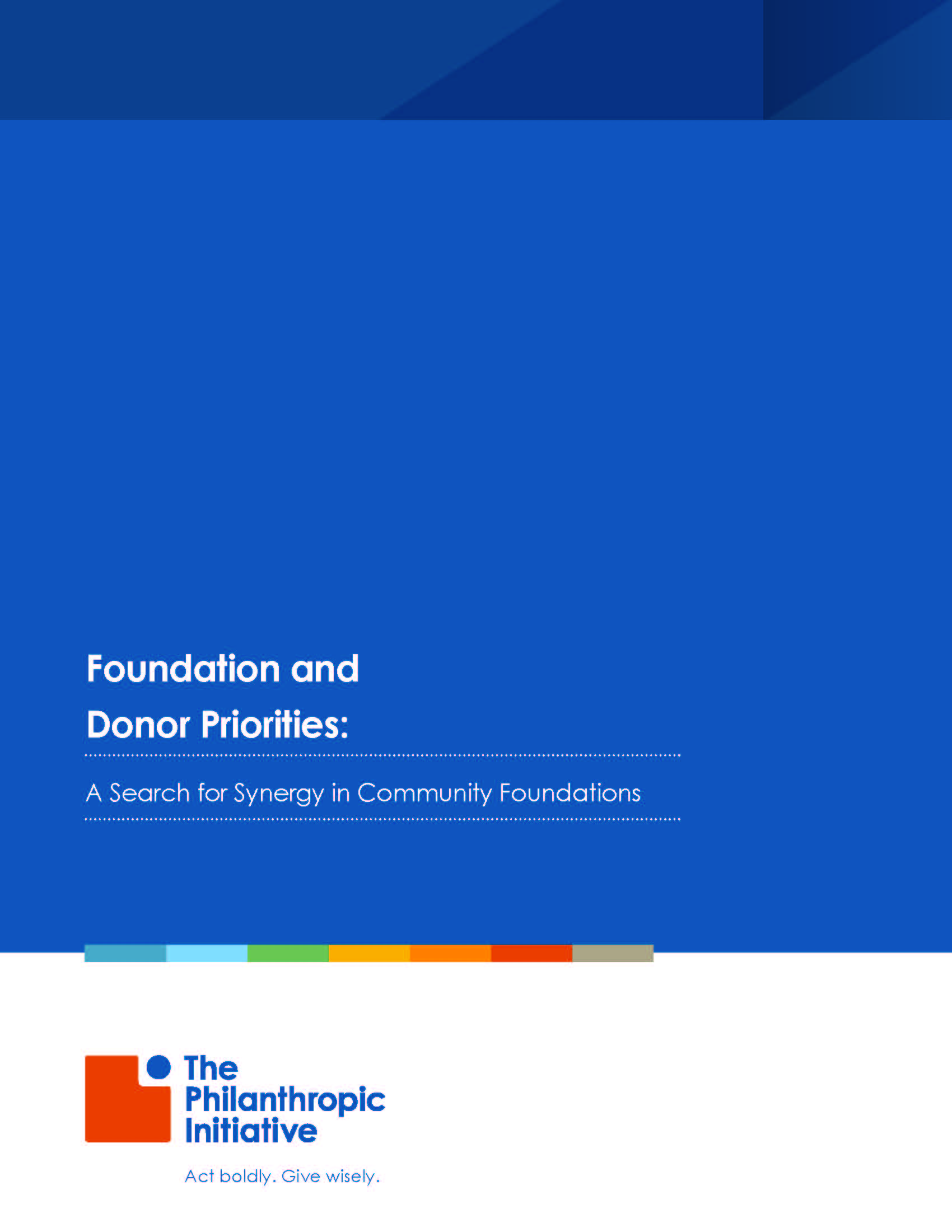
Through some of our recent work with community foundations, we’ve identified several trends in the field that we think will continue to gain momentum in 2020, including leadership through systems philanthropy, growth in civic leadership roles, and innovation in donor partnership and engagement, which is what we’re talking about today. This is Part 2 in a series we’re doing on community foundations this year, so stay tuned for more!
—
Foundation and Donor Priorities
In 2015, TPI published the report, Foundation and Donor Priorities: A Search for Synergy in Community Foundations. As stated in this publication, “There is an oft-cited mantra within the community foundation field that a foundation must choose between being ‘community centric’ and ‘donor centric,’ or between focusing on foundation-driven priorities and donor-driven priorities.” Increasingly, this is perceived as an artificial dichotomy, as some community foundations are bringing into closer collaboration and alignment their foundation-led and donor-led activities.
We believe a continuum of donor collaboration exists, and community foundations may choose where on this continuum their donor engagement focus lies, or if they want to work across the whole continuum:

The diversity of organizational cultures, staff skillsets, external messages, and internal infrastructures needed to support both community-centric and donor-centric goals within a single organization can create a challenging balancing act for community foundations. In addition, a foundation’s history, size of endowment, and primary source of funding add complexity to how a foundation can engage their donors. For example, an older foundation with an established endowment may have more flexibility to focus efforts on foundation-led priorities. Whereas a smaller foundation whose existence has been largely driven by the members in their community may need to focus primarily on efforts led by donors.
In any case, since our 2015 report came out, we’ve seen more community foundations willing and wanting to grapple with how to find a balance between foundation- and donor-led priorities that works best for the organization, their donors, and the communities in which they work. Community foundations are breaking new ground in donor engagement and co-creation of philanthropic strategies, and we hope that community foundations around the country can continue to learn from each other’s experiences in this area.
The Boston Foundation’s Early Childhood Donor Collaboration
One specific example we want to share today is the Boston Foundation’s co-creation of an Early Childhood Program strategy in collaboration with donors. One of the oldest community foundations in the nation, the Boston Foundation (TBF) has more discretionary capital than many community foundations, which has enabled it to operate largely through foundation leadership. While in the past, TBF has collaborated with donors on discrete projects, TBF’s recent focus on donor engagement in early childhood represented a new direction: engaging in partnership with donors to co-create strategy and visibility in a whole new program area.
TBF recently engaged TPI to evaluate the process and impact of TBF’s Early Childhood donor engagement pilot – a joint effort of TBF’s Program team and Development and Donor Services (DDS) team – following its first three years of operation. As part of its 2015 Strategic Plan, TBF committed to developing an early childhood strategy and to greater collaboration with its community of donors as an initial experiment in mobilizing capital in alignment with institutional priorities and donor interests.
Staff from DDS and the Program team co-designed a strategy and set of activities to engage a group of eight donors and two TBF Board members to participate in an Early Childhood Funders Collaborative (ECFC), with goals to:
- Foster organized, intentional collaboration among the TBF Program team, DDS, and donors interested in early childhood grantmaking
- Learn together about the early childhood field
- Co-create a TBF funding strategy to support early childhood needs in Greater Boston
- Help TBF identify its role and value-add in early childhood
- Pilot a model of co-investment that adds value to donors’ experiences inclusive of deeper connections with TBF staff and other donors
- Increase TBF’s overall funding for early childhood initiatives
Donors participate with TBF in ECFC as thought partners, co-designers, and co-investors. Since 2016, the Collaborative has convened a few times each year through TBF Donor Dialogue sessions, an Idea Lab, and Research Roundtable opportunities. In June 2018, TBF underwent an open Request for Proposal (RFP) process to provide one-year grants to ten organizations working on cross-sector partnerships. Today, TBF continues to dedicate resources to grantmaking through its Early Childhood Program, and this funding is influenced by the interests and priorities of donors participating in ECFC. For example, investment in children and families from birth to age three and increasing capacity for cross-sector partnerships to support them remains central to TBF’s Program strategy.
Results and Impact
TBF’s hypothesis about early childhood donor engagement was: if donors come in at the beginning and co-create strategy together with TBF, then donors will be more likely to increase participation in philanthropy focused on early childhood. Turns out, they were right. More than two-thirds of the 2018 RFP investment was donor-contributed. As a result of their experience with ECFC, several participating donors dramatically increased their early childhood giving through their DAFs, and annual funding through TBF of early childhood was up 92% in 2019 compared to 2016.
In addition to increased early childhood funding in Greater Boston, the ECFC resulted in:
- Significant learning by both staff and donors about early childhood
- Greater TBF brand equity in the community
- Increased trust and cooperation among TBF staff and donors
- A unique cross-departmental collaboration opportunity for DDS and Program staff
- Increased capacity for cross-sector partnerships in Greater Boston communities to support children and families from birth to age three
Lessons Learned
TBF launched ECFC with a blue-sky openness to co-create with staff and donors – without a defined set of annual goals, roles, or activities. While the results of ECFC’s first years are extremely positive, the fluidity and uniqueness of the collaborative model has posed some initial challenges for TBF. While TBF staff were navigating their first foray into foundation and donor collaboration through the ECFC, Program and DDS staff had to also navigate the internal dynamics of co-leading and co-designing grantmaking strategy and operations for the first time. As TBF’s Early Childhood focus and ECFC activity evolves from pilot to Program, periodic recalibration of co-leadership roles, process, and donor and staff activities has been performed. In addition, as TBF’s Early Childhood Program matures and now operates within the Foundation’s broader Program structure and governance, maintaining the balance between TBF taking the lead on early childhood strategic initiatives and supporting donors in their own giving is requiring an intentional, coordinated approach to communication, strategy, implementation, management, and operations.
Moving Forward
With lessons learned from this first experiment in collaboration and co-creation, TBF is looking more broadly at other donor engagement opportunities. Donors were very positive about their involvement in ECFC and the collaborative’s impact on themselves, TBF, and the community. TBF and donors view ECFC as a promising way to learn together about a new issue area, and TBF is now seeking to answer: What does successful donor partnership look like? Where does TBF want its donor collaboration to be on the spectrum from Foundation Leadership to Donor Leadership? What is required internally to make such collaborations work? What are appropriate goals and expectations for meaningful donor collaboration?
Takeaway
TPI’s evaluation findings suggest that engaged donors can bring in more resources and play effective roles in community foundation strategy development and grantmaking. At TBF, donor engagement broadened learning and expertise, deepened donor commitment to funding in early childhood, and strengthened donor relationships with the Foundation. As community foundations continue to search for ways to innovate, attract funds, and demonstrate their value, donor collaboration could be a win for foundations willing to share decision-making power and invest in the collaborative process.
—
Thanks to Kate Guedj (TBF Senior Vice President and Chief Philanthropy Officer), the TBF Development & Donor Services team, Orlando Watkins (TBF Vice President of Programs), and the TBF Early Childhood Program team for their thoughtful contributions.
And thanks to Ellen Remmer (TPI Senior Partner) for developing TPI’s publication, Foundation and Donor Priorities: A Search for Synergy in Community Foundations, and for leading related field-building initiatives.
—
For research and insights on effective donor collaboratives and donor engagement, check out TPI’s primer, Donor Collaboration: Power in Numbers. If you have insights into the role of community foundations in donor engagement or would like to share your foundation’s work, we’d love to hear from you!
For more than 30 years, TPI has been committed to and actively involved in the community foundation movement. We value the role of community foundations as community leaders and as a powerful force in deepening donors’ engagement in their philanthropic giving and in growing the impact of philanthropy in their communities. Since 2012, TPI has been an operating unit of the Boston Foundation, and continues to support and partner with community foundations around the country and throughout the world.


